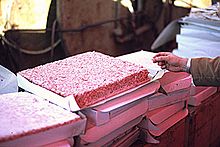Krill Oil Extraction Methods
How Is Krill Oil Extracted?
I asked a simple question that ended our tour of the krill oil factory, “How do chemicals and solvents fit into a product with ‘natural’ on the label?” … he ended the tour and asked us not to return.
Because how your krill oil is extracted does make a difference to the potential benefits. Whether to the actual nutrient count, freshness or potential for oxidation – extraction matters.[1]
Solvent/Chemical Extraction Methods

Most manufacturers today use some form of solvent based extraction. In simple terms, solvent based extraction uses a liquid or chemical of some kind – in this case, often hexane – to separate oil from the krill themselves.[2] Once the chemical solvent is added, the solid bits of krill are filtered out.
The amount of the solvent left in the oil depends on the filtration method. But in general, once a foreign substance is added it’s nearly impossible to get every trace of it back out.
We’ve seen some manufacturers tout a “supercritical solvent extraction.”[3] This is a slightly more complex process that involves using heat and pressure to get the solvent to it’s “critical point.”[4] The critical point is a thermodynamics term that means the liquid in a state where it can be both a liquid and a vapor at the same time.
We’re confused too…
Conclusion: Solvent-based extraction methods unavoidably add solvents and chemicals to your krill oil that must then be removed by further processing. How thoroughly they’re removed will vary, but at a minimum, there will be traces of solvents in your krill oil supplement. And supercritical solvent methods also involve heat and pressure, which increase the risk of oxidation.[5]
Non-Solvent, Mechanical Extraction
In the last 2-3 years, an old process has re-emerged for extracting krill oil, mechanical extraction.
With this method, krill are harvested using vacuum pumps that deliver the krill directly to the extraction equipment on board the ship, so the oil is extracted within minutes of capture.
Instead of chemicals or solvents, the krill are taken through a process that ends with mechanical pressing to extract a higher grade of krill oil.[6]
This method is faster – there is no wait time between harvest and extraction. It’s cleaner – no solvents or foreign substances are ever added to the krill. And it delivers an oil that in most lab tests has even higher amounts of critical nutrients.[7]
Conclusion: A non-solvent based extraction product should be better for our health.
Krill Harvest Date?
As Krill Oil has grown in popularity, manufacturers have had little choice but move towards mass production techiniques. Many popular products have made some unsettling adjustments as the need for more and more output placed demands on their processes.
In many cases, this has led to extraction methods that use chemical solvents, as mentioned above. Even worse, it’s led to giant warehouses where extracted oil waits for months at a time in metal drums to be encapsulated. This increases opportunities for oxidation[8] and degradation of important krill oil nutrients. [9]
These methods and wait times have forced manufacturers to further manipulate their product (larger dosage, bottled date, etc.) to achieve even the basic nutrient numbers.[10]
Conclusion: Be wary of anyone hyping their “freshly bottled date” a little too much.
For more information on choosing a krill oil supplement, see Krill Oil Product Recommendations.
See Also:
- Krill Oil Product Recommendations
- Krill Oil
- Krill Oil – How To Choose?
- Krill Oil Benefits
- Omega-3 Fatty Acids
- ^ Gigliotti, Joseph C., et al. “Extraction and characterisation of lipids from Antarctic krill (Euphausia superba).” Food Chemistry 125.3 (2011): 1028-1036.
- ^ “Solvent extraction.” Wikipedia, The Free Encyclopedia. 16 Jan 2016, 14:42 UTC. 16 Aug 2016, 17:52 <https://simple.wikipedia.org/w/index.php?title=Solvent_extraction&oldid=5303140>.
- ^ Yamaguchi, Katsumi, et al. “Supercritical carbon dioxide extraction of oils from Antarctic krill.” Journal of Agricultural and Food Chemistry34.5 (1986): 904-907.
- ^ Wikipedia contributors. “Supercritical fluid extraction.” Wikipedia, The Free Encyclopedia. Wikipedia, The Free Encyclopedia, 6 Aug. 2016. Web. 16 Aug. 2016.
- ^ Ali-Nehari, Abdelkader, et al. “Characterization of oil including astaxanthin extracted from krill (Euphausia superba) using supercritical carbon dioxide and organic solvent as comparative method.” Korean Journal of Chemical Engineering 29.3 (2012): 329-336.
- ^ Rogozhin, Sergei Vasilievich, et al. “Emulsification method for the processing of krill to produce protein, lipids and chitin.” U.S. Patent No. 4,119,619. 10 Oct. 1978.
- ^ ibid
- ^ Kołakowska, Anna. “The oxidability of krill lipids.” Pol Polar Res 12 (1991): 89-94.
- ^ Bustos, Rubén, et al. “Oxidative stability of carotenoid pigments and polyunsaturated fatty acids in microparticulate diets containing krill oil for nutrition of marine fish larvae.” Journal of Food Engineering 56.2 (2003): 289-293.
- ^ Lu, Henna Fung Sieng, Inge Bruheim, and Charlotte Jacobsen. “Oxidative stability and non‐enzymatic browning reactions in Antarctic krill oil (Euphausia superba).” Lipid Technology 26.5 (2014): 111-114.
